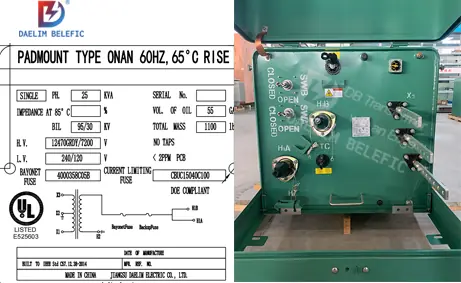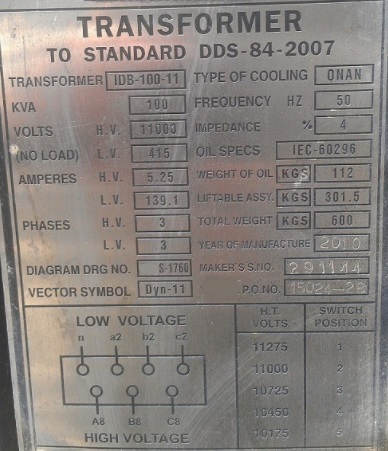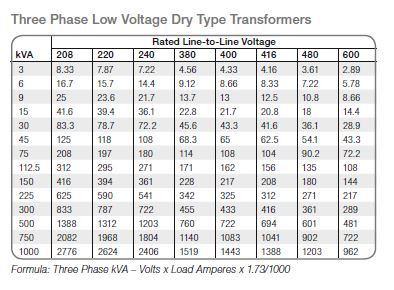A 25kVA transformer can deliver up to 104.2 amps at 240 volts. At 480 volts, it can deliver 52.1 amps.
A transformer is a crucial component in electrical systems, responsible for transferring electrical energy between circuits. The 25kVA transformer is commonly used in both residential and commercial applications to step down or step up voltage levels. Understanding its capacity in terms of amps helps in selecting the right transformer for specific needs.
Knowing the amperage is essential for ensuring the safety and efficiency of electrical systems. This information aids in proper installation and maintenance, preventing overloads and ensuring reliable power distribution. Selecting the right transformer also contributes to energy efficiency and cost savings in the long run.
Credit: www.quora.com
Introduction To 25kva Transformers
A 25Kva transformer is a key component in electrical systems. It changes voltage levels to ensure safe and efficient power distribution. Understanding its role can help you appreciate its importance.
Basic Concepts
A transformer works on the principle of electromagnetic induction. It has two coils: the primary and the secondary. The primary coil receives the input voltage. The secondary coil delivers the output voltage. The ratio of these voltages depends on the number of turns in each coil.
The term Kva stands for Kilovolt-Amperes. It measures the transformer’s apparent power. A 25Kva transformer can handle 25,000 volt-amperes. This specification helps determine the transformer’s capacity.
Importance In Electrical Systems
Transformers are crucial for distributing electricity efficiently. They step up or step down voltages to match the needs of different devices. This prevents damage and ensures safety.
A 25Kva transformer is common in both residential and commercial settings. It supports various applications, from powering homes to running industrial equipment. Proper usage ensures stable and reliable power supply.
| Specification | Details |
|---|---|
| Power Rating | 25,000 volt-amperes |
| Primary Voltage | Varies by design |
| Secondary Voltage | Varies by design |
| Application | Residential, Commercial, Industrial |
- Transforms voltage levels safely.
- Ensures efficient power distribution.
- Prevents electrical damage.
- Understand the transformer’s capacity.
- Ensure proper installation.
- Regularly maintain for best performance.
Calculating Transformer Amps
Understanding how to calculate transformer amps is essential for electrical projects. This process ensures that your transformer operates safely and efficiently. Below, we’ll explore formulas and methods, and look at practical examples for a 25Kva transformer.
Formulas And Methods
To calculate transformer amps, you need to know the transformer’s power rating and the voltage levels. The formula to determine the current (in amps) is:
Current (Amps) = Power (VA) / Voltage (V)
For a single-phase transformer:
Current (Amps) = Power (VA) / Voltage (V)
For a three-phase transformer, the formula is slightly different:
Current (Amps) = Power (VA) / (Voltage (V) √3)
Practical Examples
Let’s look at some practical examples of calculating amps for a 25Kva transformer.
Example 1: Single-phase transformer with a voltage of 240V.
Current (Amps) = 25,000 VA / 240 V = 104.17 Amps
Example 2: Three-phase transformer with a voltage of 240V.
Current (Amps) = 25,000 VA / (240 V √3) = 60.14 Amps
These calculations help you determine the suitable transformer size for your application. Always ensure your calculations are accurate and double-check your results.
Factors Affecting Efficiency
Understanding the factors affecting efficiency of a 25Kva transformer is crucial. This knowledge helps in optimizing its performance and extending its lifespan. Two main factors play a significant role: load variability and temperature influences.
Load Variability
Load variability refers to the changes in the electrical demand on the transformer. High fluctuations can cause the transformer to overheat. This reduces its efficiency and lifespan.
Managing load variability is essential. Consistent loads ensure better performance. Extreme variations in load can lead to energy losses. It’s important to monitor and regulate the load to maintain efficiency.
Consider the following tips to manage load variability:
- Install load monitoring systems.
- Ensure balanced loads across phases.
- Use surge protectors to handle spikes.
Temperature Influences
Temperature plays a vital role in the efficiency of a 25Kva transformer. High temperatures can cause insulation breakdown. This leads to reduced efficiency and potential failure.
It’s crucial to maintain optimal operating temperatures. Use cooling systems like fans or oil coolers. Regular maintenance checks help in identifying temperature-related issues early.
Follow these steps to manage temperature influences:
- Regularly check transformer oil levels.
- Ensure proper ventilation around the transformer.
- Use thermal imaging to detect hot spots.
By understanding and managing these factors, you can ensure your 25Kva transformer operates efficiently and has a longer lifespan.
Performance Optimization Techniques
Optimizing the performance of a 25Kva transformer is essential for efficiency. Proper techniques ensure longevity and reduce operational costs. Here, we explore key performance optimization methods.
Regular Maintenance
Regular maintenance keeps your transformer in top condition. Routine checks identify potential issues early. Key maintenance tasks include:
- Inspecting oil levels
- Checking for leaks
- Cleaning cooling fins
- Tightening connections
Oil testing is crucial. It detects moisture and contaminants. Replace oil if needed. Visual inspections are also important. Look for signs of wear or damage.
Advanced Monitoring Systems
Advanced monitoring systems provide real-time data. They help in predictive maintenance. Key features include:
| Feature | Benefit |
|---|---|
| Temperature Sensors | Prevent overheating |
| Load Monitoring | Optimize load distribution |
| Oil Quality Sensors | Ensure oil health |
Remote monitoring allows for continuous oversight. It reduces the need for manual inspections. Data analytics can predict failures. This helps in timely interventions.
Energy Loss Minimization
Energy loss in a 25Kva transformer can significantly affect performance. Minimizing these losses ensures efficiency and cost-effectiveness. The two main types of losses in transformers are core losses and copper losses. Understanding and reducing these losses can lead to substantial energy savings.
Core Losses
Core losses occur due to the alternating magnetic field in the transformer core. These losses are also known as iron losses. They are divided into two types:
- Hysteresis Losses: Caused by the lagging of magnetic domains behind the magnetizing force. Using high-quality magnetic material can reduce these losses.
- Eddy Current Losses: Induced currents within the core material cause these losses. Laminating the core reduces eddy current losses.
Reducing core losses involves using better materials and improved designs. This helps in achieving better energy efficiency.
Copper Losses
Copper losses are due to the resistance in the transformer windings. They are also known as winding losses. These losses can be calculated using the formula:
P_loss = I^2 R
Where I is the current and R is the resistance.
Minimizing copper losses involves:
- Using conductors with lower resistance.
- Ensuring proper winding techniques.
- Maintaining optimal operating conditions.
Proper maintenance and regular checks can help in keeping these losses to a minimum.
Summary Table
| Type of Loss | Cause | Minimization Technique |
|---|---|---|
| Core Losses | Magnetic field changes | Use high-quality materials |
| Copper Losses | Winding resistance | Use low-resistance conductors |

Credit: www.daelimtransformer.com
Comparing Different Transformer Types
Understanding the different types of transformers is essential. It helps in selecting the right one for specific needs. Here, we compare various transformer types.
Dry Type Vs. Oil-filled
Dry type transformers use air for cooling. They are safer for indoor use. They are also easier to install and maintain.
Oil-filled transformers use oil as a coolant. They are more efficient in cooling. They are suitable for outdoor installations. They have a longer lifespan compared to dry type.
| Feature | Dry Type | Oil-Filled |
|---|---|---|
| Cooling Method | Air | Oil |
| Installation | Indoor | Outdoor |
| Maintenance | Easy | Requires more |
| Efficiency | Moderate | High |
Single-phase Vs. Three-phase
Single-phase transformers are simpler and cheaper. They are used for residential and light commercial applications.
Three-phase transformers are more complex and expensive. They are used for industrial and heavy commercial applications. They provide better power distribution.
- Single-phase is best for smaller loads.
- Three-phase is best for larger loads.
By comparing these types, choosing the right transformer becomes easier.
Real-world Applications
The 25Kva Transformer Amps offers versatile uses in various real-world applications. These transformers efficiently convert electrical power for diverse needs.
Industrial Uses
In the industrial sector, 25Kva transformers play a critical role. They ensure machinery operates smoothly and efficiently.
- Manufacturing plants use them to power heavy-duty equipment.
- Warehouses depend on them for lighting and climate control.
- Construction sites utilize portable transformers for temporary power needs.
These transformers handle large power loads with ease. They ensure industrial processes are uninterrupted.
Commercial And Residential Uses
Commercial and residential properties also benefit from 25Kva transformers. They offer reliable power conversion for everyday needs.
| Application | Benefit |
|---|---|
| Office Buildings | Provide stable power for computers and lighting. |
| Retail Stores | Support electrical systems for displays and security. |
| Homes | Ensure appliances run smoothly and safely. |
These transformers offer a robust solution for varied power needs. They ensure safety and efficiency in commercial and residential settings.

Credit: production-technology.org
Future Trends In Transformer Technology
Transformers have been crucial in electrical systems for years. The evolving technology promises even more efficiency and smart solutions. Here, we explore emerging trends in transformer technology.
Smart Transformers
Smart transformers are revolutionizing the electrical grid. They use advanced sensors and control systems. These transformers can adapt to changing loads and conditions. They offer real-time data on performance and health. This leads to better maintenance and reduced downtime.
Smart transformers also support grid modernization. They enable better energy distribution and reliability. They can communicate with other devices, improving overall grid management. This technology is paving the way for a more resilient and efficient power grid.
Sustainability And Green Tech
Transformers are becoming more eco-friendly. New materials and designs reduce energy losses. This makes them more efficient and sustainable. There is a focus on using biodegradable and recyclable materials.
Green transformers help lower carbon footprints. They support the integration of renewable energy sources. This aligns with global goals for a cleaner environment.
Here are some key features of green transformers:
- Reduced energy losses
- Use of biodegradable materials
- Integration with renewable energy
- Lower carbon footprint
These advancements in transformer technology are shaping a sustainable future. They ensure better performance and support environmental goals.
Frequently Asked Questions
How Many Amps Is 25 Kva Good For?
A 25 kVA transformer typically supports around 104 amps at 240 volts single-phase. For three-phase, it’s about 35 amps.
How Many Amps Is 25kw?
To find the amps for 25kW, use the formula: Amps = kW / Volts. For a 240V system, it’s 104. 17 amps.
What Is 25kva Transformer Rating?
A 25kVA transformer has a power rating of 25 kilovolt-amperes. It indicates the transformer’s capacity to handle electrical load.
How Many Amps Does A 30kva Transformer Draw?
A 30kVA transformer draws approximately 125 amps at 240 volts. This is calculated using the formula: Current (I) = Power (P) / Voltage (V).
Conclusion
Understanding the amps of a 25Kva transformer is crucial for efficient energy use. Proper knowledge helps in better planning and safety. Make sure to consult experts for accurate installation. This ensures optimal performance and longevity of your transformer. Stay informed and make wise electrical decisions.


